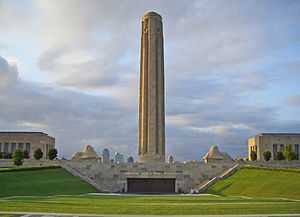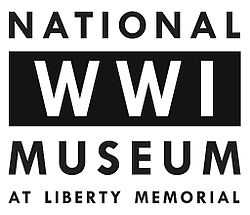National World War I Museum
| National World War I Museum | |
|---|---|
|
The new logo of the museum | |
| Location | Liberty Memorial, Kansas City, Missouri, United States |
| Nearest parking | On site (no charge) |
| Website |
www |
The National World War I Museum of the United States is located in Kansas City, Missouri. Opened to the public as the Liberty Memorial Museum in 1926, it was designated in 2004 by the United States Congress as America's official museum dedicated to World War I. The museum re-opened to the public in December 2006 with an expanded, award-winning facility to exhibit an artifact collection that began in 1920.[1][2] The National World War I Museum tells the story of the Great War and related global events from their origins before 1914 through the 1918 Armistice and 1919 Paris Peace Conference. Visitors enter the 32,000-square-foot (3,000 m2) facility across a glass bridge above a field of 9,000 red poppies, each one representing one thousand combatant deaths.[3]
History
Soon after World War I ended, Kansas City leaders formed the Liberty Memorial Association (LMA) to create a lasting monument to the men and women who had served in the war. In 1919, the LMA and citizens of Kansas City raised more than $2.5 million in 10 days in support of that mission, a reflection of the public sentiment that the Great War dramatically changed the world. In 1921, more than 100,000 people gathered for the site dedication of Liberty Memorial. Construction on the classical Egyptian Revival-style monument was completed in 1926 and the Liberty Memorial was dedicated by President Calvin Coolidge on November 11, 1926 with the statement,[4] “[The Liberty Memorial] has not been raised to commemorate war and victory, but rather the results of war and victory which are embodied in peace and liberty…. Today I return in order that I may place the official sanction of the national government upon one of the most elaborate and impressive memorials that adorn our country. The magnitude of this memorial, and the broad base of popular support on which it rests, can scarcely fail to excite national wonder and admiration.”[5]
In the years following its unveiling, the Liberty Memorial proved a dynamic addition to Kansas City’s cultural offerings. Over time, however, the physical structure of the Liberty Memorial deteriorated, and it was closed in 1994 due to safety concerns. Kansas citizens voiced their support for the Liberty Memorial and, in 1998, they passed a limited-run sales tax to support the restoration. In addition to revitalizing the Memorial, plans took shape to expand the site by building a museum to better showcase the WWI-related objects and documents the LMA had been collecting since 1920.
Generous local, national and international support provided more than $102 million for restoration and expansion. In 2004, the museum was designated by Congress as the nation's official World War I museum, and construction started on a new 80,000 square foot, state-of-the-art museum and the Edward Jones Research Center underneath the Liberty Memorial. The Liberty Memorial was designated a National Historic Landmark on Sept. 20, 2006,[6] recognizing the monument as a nationally significant historic property. It is a distinction given to less than 40 historic properties in Missouri and slightly more than 2,500 in the United States. On December 19, 2014, President Barack Obama signed legislation recognizing the Liberty Memorial as a national memorial, which effectively redesignated the Museum as the National World War I Museum and Memorial.[7]
Mission
The National World War I Museum at Liberty Memorial inspires thought, dialogue, and learning to make the experiences of the World War I era meaningful and relevant for present and future generations.[8]
The National WWI Museum operates as non-profit organization dedicated to honoring those who served in the Great War by:
- Maintaining the Liberty Memorial as a beacon of freedom and a symbol of the courage, patriotism, sacrifice and honor of all who served in World War I
- Interpreting the history of World War I to encourage public involvement and informed decision-making
- Providing exhibitions and educational programs that engage diverse audiences
- Collecting and preserving historical materials with the highest professional standards to share the stories of the Great War through the eyes of those who lived it
Design

The exterior buildings are designed in the classical Egyptian Revival style of architecture with a limestone exterior. The foundation was constructed using sawed granite, and the exterior ground level walls are made of Bedford stone. The main doors at the bottom of a large set of stairs are made from ornamental bronze, and the walls of the first floor lobby are finished in Kasota stone, which was quarried in Kasota, Minnesota. The first floor corridor and the grand stairway are finished in travertine that was imported from Italy. The floors of the corridors and stairway treads are made from terrazzo and Kasota marble, and the balusters and railing are made from Italian travertine and Italian tavernelle clairemarble. The subterranean expansion of was designed by Ralph Appelbaum Associates and greatly expands the original facilities that are still housed on the main deck of the Liberty Memorial: Exhibition Hall and Memory Hall.[8] Memory Hall includes murals originally painted for the Panthéon de la Guerre in Paris, and adapted by LeRoy Daniel MacMorris in the 1950s.
Facilities
The Main Gallery includes:
- Exhibition of period artifacts including:
- A Renault FT tank
- Uniforms such as Paul von Hindenburg’s Model 1915 Field Jacket[9]
- 1917 Harley-Davidson motorcycle
- 1918 Ford Model T ambulance
- General John J. Pershing's Headquarter flag
- International Propaganda posters
- Allied National naval torpedo
- Interactive displays
- Two theaters that provide visitors with educational narratives on why the Great War began and why the United States became involved in World War I.
- Replica trenches
The complex also includes:
- Edward Jones Research Center is a non-circulating library of over 8,000 volumes
- Multi-purpose conference room and classroom
- Museum store
- The Over There Café
See also
- National Civil War Museum
- National World War II Museum
References
- ↑ "National World War I Museum". SEGD.org. Society for Experiential Graphic Design. 2013. Retrieved 2014-11-25.
- ↑ Bernard, Murrye (July 2010). "Names in the News". Main.AIANY.org. American Institute of Architects. Retrieved 2014-11-25.
- ↑ Rendina, Denise (2013-02-19). "National World War I Museum at Liberty Memorial Overview" (PDF). TheWorldWar.org. National World War I Museum. Retrieved 2014-11-24.
- ↑ Christian, Shirley (1998-03-31). "World War I Museum's New Drive on the Home Front". The New York Times (New York, NY). Retrieved 2014-11-24.
- ↑ Coolidge, Calvin (1926-11-11). Address at the Dedication of the Liberty Memorial at Kansas City, Missouri (Speech). Dedication of the Liberty Memorial. Kansas City, MO. Retrieved 2014-11-25.
- ↑ Millstein, Cydney (2006-01-13). "National Historic Landmark Nomination" (PDF). NPS.gov. National Park Service. Retrieved 2014-11-24.
- ↑ Campbell, Matt (2014-12-22). "Liberty Memorial is Officially the National Memorial to World War I". The Kansas City Star (Mi-Ai Parrish). Retrieved 2014-12-30.
- ↑ 8.0 8.1 Vietti, Mike (2014-03-05). "Mission Statement and Brief History" (PDF). TheWorldWar.org. National World War I Museum. Retrieved 2014-11-25.
- ↑ "In the Spotlight". TheWorldWar.org. The National World War I Museum. 2014. Retrieved 2014-11-25.
External links
| ||||||||||||||||||||||||||
| ||||||
